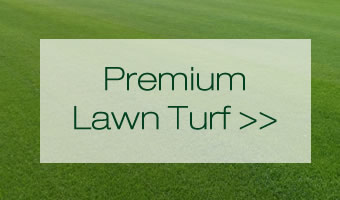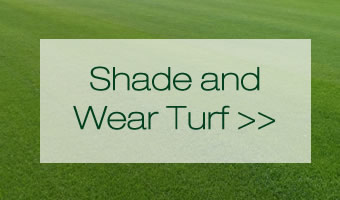Before you order your turf you should complete some basic steps.
- Calculate your area (use our advanced turf calculator to help you) This is the 1st step you should take so whatever steps you need to take next, you will be prepared with the correct quantities.
- Assess if you have enough topsoil? If you don't, we recommend Devon Topsoil for good quality loam. Or you may find a supplier closer to you. Make sure the topsoil is tested, screened and dry-stored.
- Do you have existing turf to remove? All existing turf should be removed from the area before you start to rotovate the ground. Hire a sod cutter from your local Hire Shop to save the back-braking work.
- Do you have to butt up the new turf to an existing lawn? Cut away the edge of the existing lawn to achieve a clean straight edge to lay the new turf against. Make sure the soil height is just 10 mm lower than the existing lawn... (and firm).
How do i prepare my ground for turf?
Working on your existing ground. (Don't try this in wet weather) 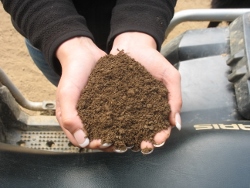 If you are not using new topsoil you will need to thoroughly turn your existing soil until it is broken down to a fine tilth. If the area is any bigger than 25sq M you will need to hire a rotovator. Rotovate in 2 or more directions across the garden until the soil reaches a crumbly fluffy texture. Remove any big stones throughout the process... A second person would be handy to stone pick the rotavated area. Use a shovel to turn in any areas the rotovator can not reach and then run the rotovator over that soil to break it down.
If you are not using new topsoil you will need to thoroughly turn your existing soil until it is broken down to a fine tilth. If the area is any bigger than 25sq M you will need to hire a rotovator. Rotovate in 2 or more directions across the garden until the soil reaches a crumbly fluffy texture. Remove any big stones throughout the process... A second person would be handy to stone pick the rotavated area. Use a shovel to turn in any areas the rotovator can not reach and then run the rotovator over that soil to break it down.
Once you have turned over the soil....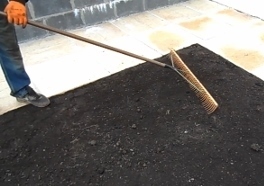 You will then need to start raking the soil. Use the widest rake you can find. Tread the soil in as you rake. Rake off any high areas first and spread the excess soil across any hollows. Repeat the process of raking and treading. If the high area or bumps become hard, you may have to rotovate that specific area again. You should be looking to obtain a firm even base with a slight tilth. (We recommend NOT using a roller. Treading the ground is just the right compaction and will allow you to find any small soft areas a roller would miss).
You will then need to start raking the soil. Use the widest rake you can find. Tread the soil in as you rake. Rake off any high areas first and spread the excess soil across any hollows. Repeat the process of raking and treading. If the high area or bumps become hard, you may have to rotovate that specific area again. You should be looking to obtain a firm even base with a slight tilth. (We recommend NOT using a roller. Treading the ground is just the right compaction and will allow you to find any small soft areas a roller would miss).
For most gardens, the ground will now be suitable to lay on.
For the perfectionist...
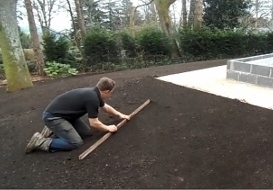 The process above a can be done in exactly the same way but as well as using a rake, you can use a straight edge. This can be anything from a professional alluminium straight edge to a 2Meter length of 100mm skirting board. Use the straight edge to screed the soil in a semi circular motion, working backwards on your knee's. (knee pads are advised). Try to start screeding from a high spot or bump and screed towards any hollow area releasing the soil evenly as you pass over the hollow. You can set up a string line across the area to obtain a good indication of level or if you are lucky enough to have a friend with a dumpy level or laser level you can check your levels with that. Borders can also be set out using a string line.
The process above a can be done in exactly the same way but as well as using a rake, you can use a straight edge. This can be anything from a professional alluminium straight edge to a 2Meter length of 100mm skirting board. Use the straight edge to screed the soil in a semi circular motion, working backwards on your knee's. (knee pads are advised). Try to start screeding from a high spot or bump and screed towards any hollow area releasing the soil evenly as you pass over the hollow. You can set up a string line across the area to obtain a good indication of level or if you are lucky enough to have a friend with a dumpy level or laser level you can check your levels with that. Borders can also be set out using a string line.
Extra Tips before laying your turf:
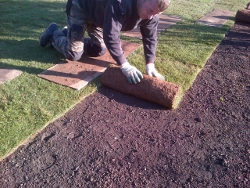
For a flush finish to a patio/path, the topsoil should be laid to the same height as the patio/path because it is likely to sink slightly and turf is of minimal depth. If you are turfing against a panel fence, you will need to lay runner boards to stop the fence rotting.If you are laying the turf on a steep gradient you will need to find some pegs to hold the turf. (large wooden food skewers are great. If you need some, tell us in the comments box of the order form and we will try and chuck a few in if we have some in stock). Although the turf is well fertilised, we advise you to add a light dose of pre-turf fertilizer to the soil before laying the turf.
Turf laying Guide:
- Start laying the turf along the longest straight edge.
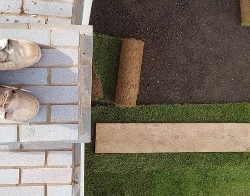
- Butt the ends together tightly, ensuring they are not overlapped.
- Once you have completed the 1st row, lay boards or scaffold planks on the top of that row.
- Start the second row with half a roll so the joints are staggered. Keep the turf tight to one another,
Continue to lay the second row, working from the boards. - Move the boards across the turf as you lay each row so you don't have to stand directly on the boards or the soil.
- If your area is circular or has curved edges, you can create your own straight line through the middle and then work each way.
- Cut the ends of the rows with a sharp knife and try to reuse any off cuts at the ends of other rows to save waste.
Extra Tips:
- Once the lawn is laid, water straight away
- Don't walk on the lawn for 2 weeks
- Mow in 2 weeks
- Try to keep off it as much as possible for 1 month to allow the roots to bind the soil together.
How to calculate how much topsoil you will need: 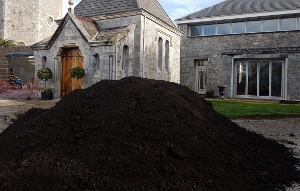
1st: Measure the area. (Result in square Meters)
2nd: Divide the area by 30
3rd: Multiply that amount by the depth in inches
4th: Answer in tons
Example:
80sq M divide by 30 = 2.666 x 4inches = 10.6 tons. (This a good guide but topsoil does vary in density)
Gardens requiring topsoil.
We would recommend a covering of 100mm/4inches of good quality topsoil on top of any subsoil. If there is no soil at all, you will need to fill at least 200mm/8inches deep. Try to remove any existing clay or create some drainage through it because it will cause problems at a later stage. Spread the soil and use the same process as in the guide given.

